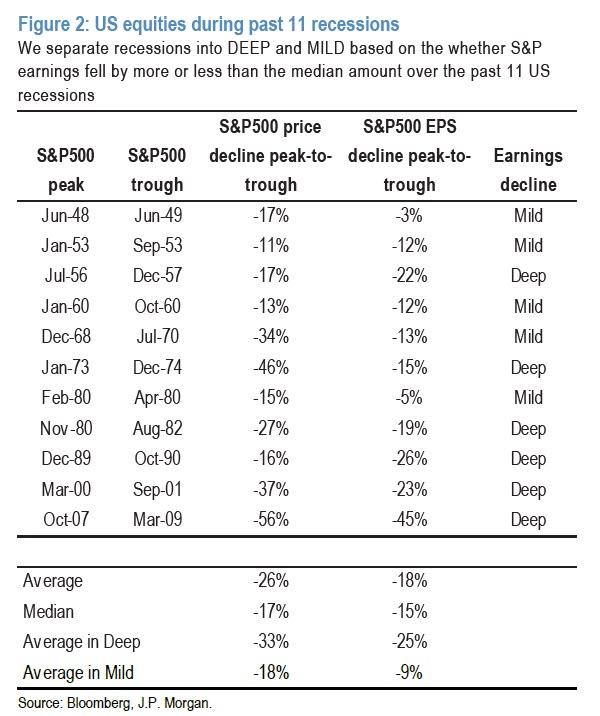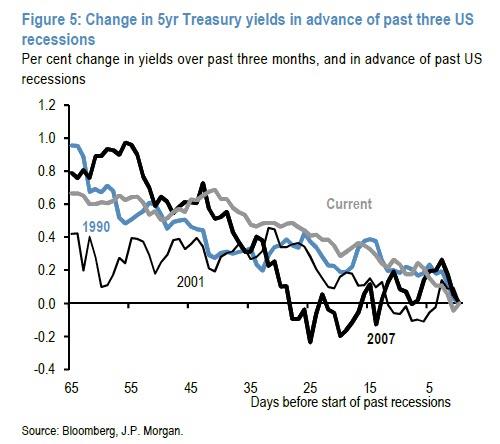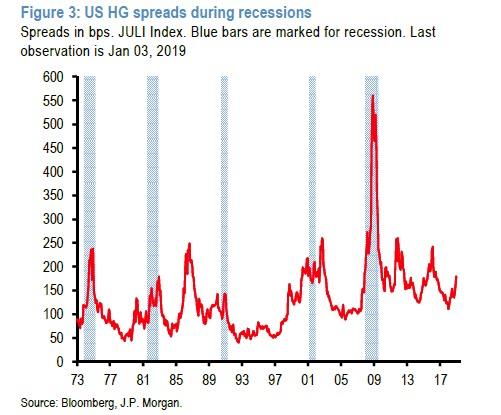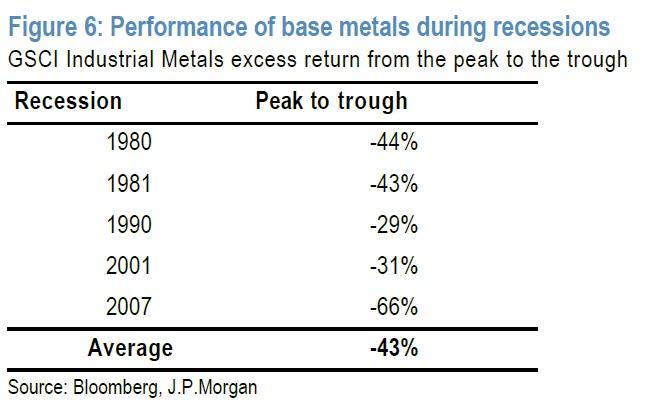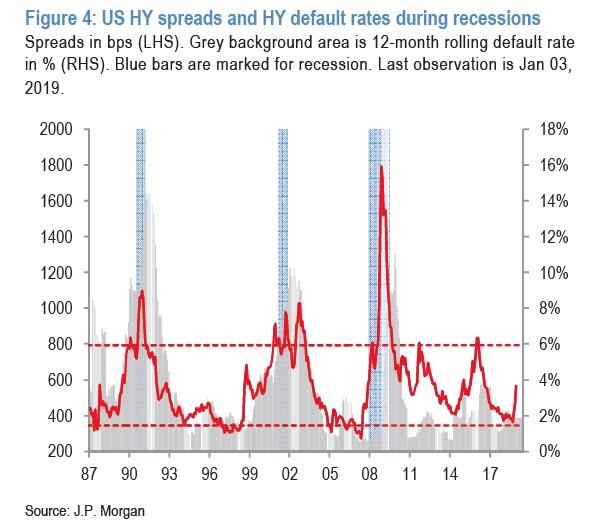Uddrag fra Zerohedge:
JP Morgans Nikolaos says that “equity markets appear to be pricing in around a 60% chance of a typical US recession.” How does he get to this number? As the JPM strategist notes, the simplest way to assess how much of a US recession is priced in is to use the average 26% decline in the S&P500 index over the past 11 recessions. So far the S&P500 has declined by 16% from its peak, so equity markets price in a 16/26=62% chance of an average recession.
An alternative way presented by JPM to calculate recession odds via the equity market is to look at earnings. Earnings have fallen by 18% on average from peak to trough in US recessions since 1948. This compares to 26% for prices. This means that earnings account for around 70% of the equity price decline during recessions. Applying the 70% to the 16% decline in the S&P500 suggests that markets already discount an 11% decline in earnings.
This compares to an average decline of 9% during MILD earnings recessions and 25% during DEEP earnings recessions. To JPM this mechanistically suggests that “a MILD earnings recession is fully priced in” although what it fails to note is that all the last four recessions – all the function of the Fed’s rolling asset bubbles bursting – resulted in deep recessions, and the coming one will likely be the “deepest” of them all. Incidentally, earnings crashed 45% during the last recession.
Looking at rates, and specificially 5Y bonds, JPM notes that “the recent 70bp fall in 5-year US Treasury yields from their early November peak points to two thirds chance of US recession on our assessment.” Here are the details:
Five-year Treasury yields fell by an average of 2.1% during the last three US recessions (measured from the peak in the three months before the recession started to the trough during the recession). That compares to a fall of around 70bp in 5-year Treasury yields since early November. This mechanically suggests that the Treasury market is pricing around a third chance of a US
recession. Of course, the low level of yields means that mechanically they cannot fall by as much as they did in some previous recessions (e.g. five-year yields fell by 3.2% during the 2007-09 recession). In fact, an argument can be made that with a lower neutral rate in the US post Lehman crisis, around half of that seen in previous cycles, 5-year UST yields should decline by half of the 2.1% peak to trough seen on average in the previous recessions. This means that the 70bp decline in the 5- year UST yield since early November (Figure 5) points to two thirds rather than one third chance of US recession.
A similar, if slightly lower odds of a recession are flashing in the High Grade Corporate bond market, where credit spreads suggests a 55% chance of a US recession. How does JPM calculates these odds?
First the bank notes that US HG credit spreads have widened sharply over the past month and currently stand at 185bp over USTs. “This suggests that HG credit markets price in (185-113)/(200-125)=83% chance of US recession and are discounting tail-like market risk scenarios.” Yet, relative to previous recessions, lower Treasury yields as well as a longer average duration, lower average credit quality and a higher proportion of banks and yankee bonds in the US HG indices have led JPM’s credit strategists to believe that we should expect average spreads of 235bp in a recession and 125bp in an expansion.
“As such, we believe that US HG spreads indicate a (185-125)/(235-125)=55% likelihood of recession.”
Next, looking at the commodity market’s implied recession odds, Panagirtzoglou writes that “the performance of industrial metals over the past months suggests that commodity markets price in around a 56% chance of a typical US recession, in line with US HG, UST and US equity markets.”
Here, to avoid the potential exogenous impact of supply shocks, “which themselves have contributed to some recessions in the past” JPM looks exclusively at base metals which do not often suffer from sudden supply shocks and are also the commodity most directly related to economic growth. Quantifying recession odds simplistically, the bank’s strategist notes that the excess return of the GSCI Industrial Metals index from peak to trough over the past five recessions, was an average -43%. And with industrial metals already having fallen 24% since the recent peak on the 18th of April, based on the average 43% fall during past US recessions, JPM interprets recent performance in base metals as pricing in a 56% chance of a typical US recession.
Finally, JPM focuses on the one “outlier” market which seems to have little concerns about an imminent recession, namely US HY credit, which prices in only 12% chance of US recession. This is surprising for many, especially with increasing focus in recent months on the potential deluge of BBB “fallen angel” downgrades which would send HY spreads soaring, and yet as JPM notes US HY spreads have “only” widened to 578bp over USTs. This compares to an average HY recession level (over the past three) of 1051bp and an average level outside of recession of 516bp (as shown below). Thus, this calculation would suggest that US HY spreads are pricing in a (578-516)/(1051-516), or a very low 12% likelihood of recession. In other words, US HY credit appears to be pricing in much lower likelihood of recession relative to US HG credit… at least for now.
Putting all this together, Panagirtzoglou concludes that “with the exception of US HY credit, US equity, bond and commodity markets appear to be pricing in on average close to 60% chance of a US recession over the coming year compared to a 40% chance by our economists and 27% chance by the consensus.”
Which begs the following question: is the market – which by definition tends to discount the future – wrong, or is the JPM “house view”, and certainly consensus, just too optimistic on the odds of a recession in the coming year and how much further do risk prices have to drop before there is a tangible shift in “consensus” sentiment about the coming recession? We look forward to an explanation from that “other” JPM strategist, Marko Kolanovic, one which hopefully refrains from accusing the market of being “fake news” for realizing that the future is not quite as rosy as the JPM house view would have its clients believe.

